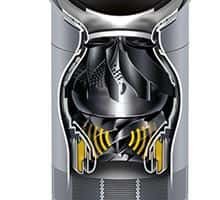
How Does Bladeless Fans Work
Bladeless fans, also known as air multipliers, have gained popularity in recent years due to their innovative design and modern aesthetics. Unlike traditional fans with visible blades, bladeless fans employ a unique technology that creates a smooth and consistent airflow. In this article, we will delve into the working principles of bladeless fans and explore their advantages.
The Design
At first glance, bladeless fans may appear as a cylindrical or oval-shaped device with no visible blades in the traditional sense. The main components of a bladeless fan include:
Also Read: Best Bladeless Cooling Fan
- Base and Motor: The base houses the motor, which is the primary component responsible for generating airflow. The motor is typically a brushless electric motor that is both powerful and energy-efficient.
- Airfoil-shaped Ring: Surrounding the base is an airfoil-shaped ring that has a curved surface. This ring acts as an amplifier for the incoming air, helping to increase the airflow while maintaining a smooth and consistent flow.
- Air Intake: Located at the base of the fan, there is an air intake mechanism that draws air into the device. The air intake often includes a filter to prevent dust and debris from entering the fan and affecting its performance.
- Airflow Control: Bladeless fans often come with various speed settings and oscillation capabilities to control the direction and intensity of the airflow. These features allow users to customize the cooling experience according to their preferences.

Working Principle of Bladeless Fans
Bladeless fans achieve their airflow through a unique combination of engineering and physics. Instead of blades, these fans utilize a brushless electric motor to generate power. The motor draws in air and directs it into the base of the fan. From there, the air is propelled through a hollow ring that surrounds the fan, creating a circular flow. This circular flow of air is then accelerated and released through an airfoil-shaped ramp, resulting in a steady and continuous breeze.

Air Multiplier Technology
The key innovation behind bladeless fans is the air multiplier technology. Instead of using traditional fan blades to create airflow, bladeless fans employ a different mechanism that works as follows:
Air Intake
When the fan is turned on, the air intake mechanism draws surrounding air into the base of the fan. The air passes through the filter, ensuring that it remains clean and free from impurities.
Also Read: Top Bladeless Ceiling Fan with Light
Air Amplification
As the air enters the base, it encounters a small and powerful brushless electric motor. The motor sucks in the air and pushes it into the hollow center of the airfoil-shaped ring. This creates a low-pressure region, causing more air to be drawn in from the surroundings.
Airflow Acceleration
The air inside the hollow ring travels at high velocity due to the motor’s force. As the air reaches the curved surface of the ring, it undergoes a process known as inducement. This occurs when the fast-moving air stream adheres to the surface of the ring, creating a thin layer of air that follows the contour of the ring.
Air Projection
The air adhering to the ring’s surface exits through a narrow slit or aperture located at the front of the fan. This accelerated and focused stream of air creates a continuous and uninterrupted airflow. The absence of visible blades results in a smooth and quiet operation.
Also Read: How to Choose a Best Tower Fan
Components of Bladeless Fans
Bladeless fans consist of several key components that work together to deliver a seamless cooling experience. The main components include the housing unit and base, the brushless electric motor, the airfoil-shaped ramp, and the hollow ring. The housing unit and base provide stability and house the internal mechanisms of the fan. The brushless electric motor, known for its efficiency and quiet operation, is responsible for generating the power needed to propel the airflow. The airfoil-shaped ramp serves to accelerate and release the airflow, while the hollow ring provides the circular pathway for the air to follow.

Advantages of Bladeless Fans
Bladeless fans offer several advantages over traditional fans, which have contributed to their growing popularity. Some notable benefits include:
Safety
Bladeless fans are considered safer than traditional fans because there are no exposed blades. This eliminates the risk of accidental contact and injuries, making them suitable for households with children or pets.
Smooth and Continuous Airflow
The absence of rotating blades in bladeless fans results in a steady and uninterrupted airflow. The airflow remains consistent, providing a more comfortable cooling experience.
Also Read: How Does a Ceiling Fan Work
Quiet Operation
Bladeless fans tend to operate more quietly compared to traditional fans. Without the noise caused by rotating blades, bladeless fans offer a quieter environment, making them suitable for bedrooms, offices, and other noise-sensitive areas.
Ease of Cleaning
Bladeless fans are generally easier to clean than traditional fans. Since there are no blades to dismantle and clean individually, a simple wipe-down of the external surfaces and occasional cleaning of the air intake and filter are usually sufficient.
Aesthetics
Bladeless fans have a sleek and modern design that can enhance the aesthetics of a room. The absence of visible blades gives them a minimalist look, making them a stylish addition to any space.
Limitations and Considerations
While bladeless fans offer many benefits, there are a few limitations and considerations to keep in mind. One factor to consider is the higher initial cost compared to traditional fans. Bladeless fans incorporate advanced technology, which can result in a higher price point. Additionally, the range and direction of the airflow may be more limited compared to certain fan types, which can affect their effectiveness in larger spaces.
Energy consumption is another consideration. Bladeless fans, while efficient, still consume electricity to power the motor and generate airflow. It’s important to be mindful of energy usage and choose fan settings that balance comfort and efficiency. Lastly, periodic maintenance is necessary, including filter replacement if the fan is equipped with one. This helps maintain the performance and air quality provided by the fan.
Also Read: How to wire a ceiling fan
Conclusion
In conclusion, bladeless fans operate on a unique and innovative principle to provide efficient and quiet airflow. By utilizing air multiplier technology, these fans draw in air, amplify it, and release a continuous and steady breeze into the room. With their brushless electric motors, sleek design, and enhanced safety features, bladeless fans offer a compelling alternative to traditional fans with rotating blades.
The absence of visible blades not only reduces noise but also eliminates the risk of accidents, making bladeless fans a safer option, especially for households with children or pets. Additionally, their easy maintenance and cleaning, along with their modern aesthetics, add to their appeal.
While bladeless fans may have a higher initial cost and a more limited range of airflow compared to some traditional fan types, they provide several advantages that make them worth considering. These include their noise reduction, safety benefits, easy maintenance, and stylish design.
As technology continues to advance, bladeless fans represent a significant step forward in cooling innovation. By understanding how bladeless fans work and considering their advantages and limitations, you can make an informed decision and embrace the benefits of this modern and efficient cooling solution.
